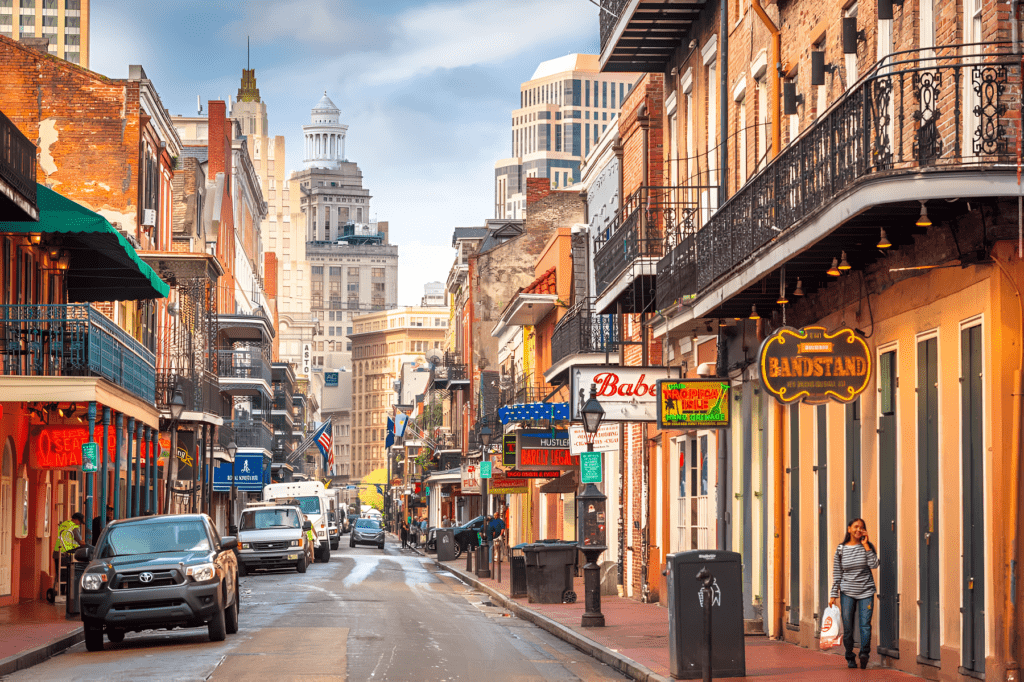Vieux Carré, or the French Quarter, is arguably the cultural center of New Orleans, Louisiana. A neighborhood where history takes the meaning of a vibrantly enriched heritage. This is a place where tourists come in droves to be part of history, to see the beautiful design, and to enjoy the buzzing life.
History
The French Quarter was founded in 1718 by Jean-Baptiste Le Moyne de Bienville. It was initially the French Quarter (even during Spanish rule) and served as that city’s center, as it later evolved into its final form. The Spanish architectural influence was the reason for a devastating fire in 1788 that destroyed much of the original French structures. Although with these changes the neighborhood somehow preserved its European look. The neighborhood is lined with French, Spanish, African, and even Caribbean cultures which took root over the years. The Quarter was so galvanized because of its melting pot of cultures.
Architectural Structure
The design of the French Quarter mixes French and Spanish provincial engineering styles. Narrow, cobblestone streets and colorful buildings are adorned with beautiful ironwork balconies. The centerpiece of the Quarter is Jackson Square, an attractive public place ringed by important sites like St. Louis Cathedral and the Cabildo. Most of the street frontage is Creole townhouses, but often with lovely little courtyards hidden behind the front. This rare colonial gem features an eclectic mix of architectural details, including Victorian and Georgian lace filigree, elaborate fretwork balconies, arched doorways, breezy courtyards, and cast-iron galleries. The French Quarter, known for its historical charm, showcases low-rise buildings that contrast with the towering modern city.
Collection of Attractions
All these things mean that there are plenty of attractions for all interests found in the French Quarter. Bourbon Street is famous for nightlife, jazz music, and bars serving 22-ounce beers, especially during college football season. Café du Monde offers delicious beignets and café au lait. You can shop for fresh foods, flowers, and local arts and crafts while enjoying the sights and sounds of the markets. History buffs can peek into 19th-century medical practices at the New Orleans Pharmacy Museum. Experience walking tours of art galleries, a voodoo shop, and a variety of boutique stores.
The Arts, Tunes, and Shade of Life
Street Artists play music in the French Quarter. This is the birthplace of jazz, meaning you can hear melodies last down its streets from buskers and organized brass bands. Music meanders through spots like Preservation Hall, where New Orleans jazz is perpetuated. If you are a fan of live music this small, quirky little establishment is one to be noticed as they nightly bring in some fantastic talent. The setting provides an intimate atmosphere for those who love their jazz, excellent and strong!
The French Quarter is also rife with art. Among its galleries, Royal Street offers art of all kinds — you will find everything from New Orleans-focused work to artwork by well-known international artists. Street performers, artists, and craftspeople hawk their wares in the middle of traffic to provide an artistic window into this vibrant neighborhood. Cultural events and festivals are celebrated all year round, which binds the community together. On the one hand, they usher in traditions worth enjoying; on the other, they add festivity to the local atmosphere.
Mardi Gras & Other Celebrations
When someone mentions New Orleans, there is only one thing that should ever come to mind, and undoubtedly, it’s the French Quarter, as well as Mardi Gras. For over 300 years, Mardi Gras has drawn people worldwide to New Orleans with its parades, music, and costumes. For two weeks, the streets are filled with floats and performers in purple, green, and gold.
Other local-focused festivals include the French Quarter Festival and Satchmo SummerFest, each celebrating traditional tunes (and tastes). New Orleans gatherings bring everyone together to enjoy special food and embrace another unique piece of the city’s culture. The French Quarter continues to build on its status as a center of culture and celebration with every festival.
Hours of Operation
Although the French Quarter is open to the public 24-7, its establishments have individual schedules. Most restaurants, shops, and galleries open around 10:00 AM and close by 6:00 PM. Bars and nightlife spots on Bourbon Street keep variable hours, often staying open until early morning. You can visit sites like Jackson Square from dawn to dusk, while the French Market operates from 9 AM to 6 PM, with hours published on websites and brochures. For more specifics, double-check separate attraction times, especially during holidays or special events.
News and News Developments
New Orleans is revitalizing the French Quarter streetscape with projects like the Passageaux Lumières glass panels, a $2 million cobblestone rehabilitation and drainage upgrade, and boosted police presence to enhance tourist safety.. The administration also debates regulating Bourbon Street at night to balance tourism with residents’ quality of life.
Latest News
Aside from infrastructure, the French Quarter is also putting more emphasis on sustainable tourism. Moreover, local organizations and the neighborhood have joined forces to reduce waste and promote green practices. The program is designed to promote respect for the historic environment on their visit, while reducing their carbon footprint. Additionally, aid now supports small businesses hit by the pandemic. The 2024 French Quarter Festival will expand, featuring more local musicians and food vendors.

